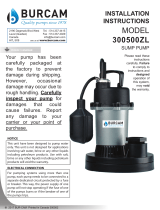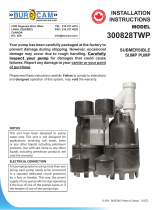Page is loading ...

2190 Dagenais West TEL: 514.337.4415
LAVAL (QUEBEC) FAX: 514.337.4029
CANADA
H7L 5X9 [email protected]
INSTALLATION
INSTRUCTIONS
MODEL
300514W
LAUNDRY TUB
PUMP
Please read these
instructions
carefully. Failure
to comply to
instructions and
designed
operation of
this system,
may void the
warranty.
© 2015 BUR-CAM Printed in Canada 300284
Your pump has been carefully packaged at the
factory to prevent damage during shipping.
However, occasional damage may occur due
to rough handling. Carefully inspect your
pump for damages that could cause failures.
Report any damage to your carrier or your
point of purchase.
WWW.BURCAM.COM

SAFETY INSTRUCTIONS:
This fine pump that you have just purchased is designed from the latest in material and
workmanship.
Before installation and operation, we recommend the following procedures:
CHECK WITH YOUR LOCAL ELECTRICAL AND PLUMBING CODES TO
ENSURE YOU COMPLY WITH THE REGULATIONS. THESE CODES HAVE
BEEN DESIGNED WITH YOUR SAFETY IN MIND. BE SURE YOU COMPLY
WITH THEM.
WE RECOMMEND THAT A SEPARATE CIRCUIT BE LEAD FROM THE HOME
ELECTRICAL DISTRIBUTION PANEL PROPERLY PROTECTED WITH A
FUSE OR A CIRCUIT BREAKER. WE ALSO RECOMMEND THAT A GROUND
FAULT CIRCUIT BE USED. CONSUL
T A LICENSED ELECTRICIAN FOR ALL
WIRING
.
THE GROUND TERMINAL ON THE THREE PRONG PLUGS SHOULD NEVER
BE REMOVED. THEY ARE SUPPLIED AND DESIGNED FOR YOUR PRO-
TECTION.
NEVER MAKE ADJUSTMENTS TO ANY ELECTRICAL APPLIANCE OR
PRODUCT WITH THE POWER CONNECTED. DO NOT ONLY UNSCREW
THE FUSE OR TRIP THE BREAKER, REMOVE THE POWER PLUG FROM
THE RECEPTACLE.
A
B
C
D
Material required for laundry tub application (indoor use only)
Desired length of ABS/DWV 1 1/4'' or 1 1/2” pipe, to link up from pump discharge to waste
or drain existing pipe.
Required quantities of 1 1/4'' or 1 1/2” ABS/DWV elbow(s) and/or other fitting(s) to run the
discharge line.
1 adaptor 1 1/4'' to 1 1/2'', if you use 1 1/2'' pipe.
1 ABS/DWV Y fitting to connect the discharge line to the
waste or drain existing pipe.
Teflon tape and ABS cement.
2
T
ools
Screwdrivers, hacksaw to cut pipe, knife to assist in pipe cutting, round file to smooth pipe
ends, pipe wrench, allen wrench.
A ball check valve is supplied to prevent the backflow of water when the pump shuts off,
and also to prevent rapid cycling of the pump and switch.
NOTICE
This unit is not designed for applications
involving salt water or brine .
Use with salt water or brine will void
warranty.

APPLICATIONS
This pump, equipped with an automatic switch, is
designed for a permanent installation to handle
normal waste water from domestic washing
machines, bar sinks located in basement play
room, and generally all waste water not
containing solids or materials which will clog the
impeller or switch operation, where the waste or
drain line is above the level for gravity flow to
sewer or septic bed connections.
CAPACITY:
2’ 1400 US GPH
4’ 1200 US GPH 8’ 800 US GPH
6’ 1000 US GPH 10’ 500 US GPH
FEATURES
High performance noryl impeller.
Automatic switch who start motor when 1 PSI
is applied to pump inlet.
Full time connected run capacitor, to eliminate
starting wear vs regular motor.
Thermal and overload protection.
Flat union, nipple, elbow, check valve included
1/3HP, 115VAC, 60Hz, 4.0A.
INSTALLATION STEPS
see typical installation diagram in page 4
We recommend that you install your pump in a clean and dry location where there is
adequate room for servicing at a later date. Protection from freezing temperatures and good
ventilation should be considered as well, to provide the pump an environment for long life.
Locate the pump directly under the strainer of laundry tub or sink as per installation diagram
(see page 4).
Friction losses in the discharge pipe must be taken into consideration when many elbows and
fittings are installed in the discharge line. Each elbows and fittings must be considered as 1
feet of head.
Never run the pump dry. Damage to the seal may occur.
THE RUN OF THE PIPE FROM THE CHECK VALVE TO THE EXISTING
WASTE OR DRAIN LINE MUST NEVER BE SLOOPING DOWNWARD
EXCEPT WHEN CONNECTING TO SAME.
Using teflon tape, install the female portion of the union under the laundry tub to the threaded
male adaptor of the strainer and screw the male part of the union, into the female pump
intake. Then screw the union to hold the pump securely in place.
Using teflon tape, screw the check valve to the pump discharge and aligned towards the
planned discharge line.
Also using teflon tape,screw the supplied ball valve to the other end of the check valve.
From the ball valve, run your length of discharge pipe, using elbows and fittings, in your
shortest possible run to the existing waste or drain line.
STEP 1
FRICTION LOSS IN
PIPE NOT INCLUDED
STEP 2
STEP 3
STEP 4
STEP 5
3

4
Connect the 3 prong plug of the switch in a receptacle. Insert the motor 3 prong plug into
female receptacle on exposed piggy-back of switch plug.
Test pump operation by filling laundry tub with water. Check all plumbing connections for
leaks and correct where necessary. The switch will activate the pump’s motor at about 1”-3”
depth of water in tub, and shut off when water will be drained out by the pump action.
The laundry pump capacity is greater than the gravity inlet flow, causing the pump to cycle
“on-off”. Upon this occurs, reduce the discharge flow with the ball valve to adjust with the
gravity flow at pump inlet, to maintain a constant flow.
LAUNDRY TUB APPLICATION
STEP 3
Screw ball check
valve to pump’s
discharge
STEP 6
STEP 7
STEP 8
STEP 7
Test pump
operation
STEP 4
Screw ball valve
to the check
valve.
STEP 5
Run the discharge
pipe
STEP 2
Using the
supplied union,
install pump
under strainer
STEP 8
Adjust
discharge flow
STEP 6
Connect switch
and pump to
receptacle

5
REPAIR PARTS
REF. PART DESCRIPTION
1 310530 Volute
2 310351 Volute screws (6)
3 310529 Impeller
4 310528 Pump gasket
5 400459 Lip seal
6 310527 Volute cover
7 310526 Pin
8 310525 Electric motor complete
9 310534 Screws (3)
10 52279 Ball valve
11 310533 Ball check valve
12 310532 Diaphragm switch
13 52261 Union
Repair parts may be ordered from your authorized point of sale or from
BUR-CAM PUMPS
For installation on a twin
laundry tub, the pump has
to be centered as per this
diagram.
After the installation of the
connecting pipe, follow the
installation steps from the
previous pages.
1
2
3
4
5
6
8
9
12 11
10
7
13
300514W 2005

6
TROUBLE SHOOTING GUIDE CHECKLIST
NEVER MAKE ADJUSTMENTS TO ANY ELECTRICAL APPLIANCE OR PRODUCT WITH THE POWER
CONNECTED. DON’T JUST UNSCREW THE FUSE OR TRIP THE BREAKER, REMOVE THE POWER
FROM THE RECEPTACLE.
Switch is off position
Blown fuse
Tripped breaker
Switch port clogged
Defective switch
Defective motor
Improper voltage
‘P’ trap between strainer and pump
Improper voltage
‘P’ trap between strainer and pump
Defective switch
Air in suction line
Missing check valve
Clogged check valve in open position
Defective switch
Pump discharge too fast on low head
Water pumped faster than tub is filled
Turn switch to on position
Replace
Reset
Remove and clean switch, port, adaptor
Replace
Replace
Check voltage
Remove
Check voltage
Remove
Replace
Check for proper pipe slope to pump inlet
Install valve
Clean debris
Replace
Install ball valve in discharge line to
reduce flow rate
It is normal
TROUBLE PROBABLE CAUSE ACTION
Motor does not
run.
Motor runs but
no water is
delivered.
Pump does not
shut off.
Pump does not
deliver to full
capacity.
Pump starts and
stop too often.
TO THE END CONSUMER
If you have any problems with the product, before advising the store, where you’ve
purchased the pump, please contact us at 514 337-4415 , and ask for our sales
department, and they will be pleased to help you with any questions you might have,
concerning your installation.
/



